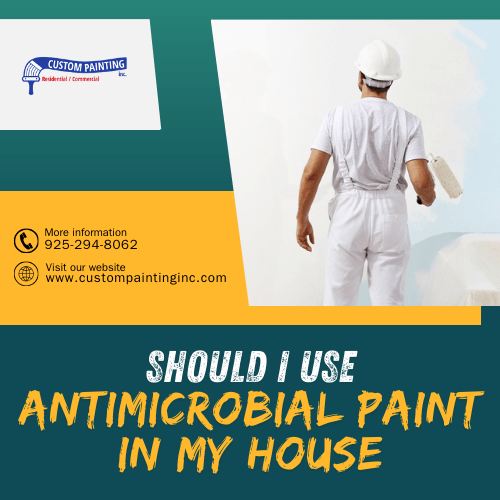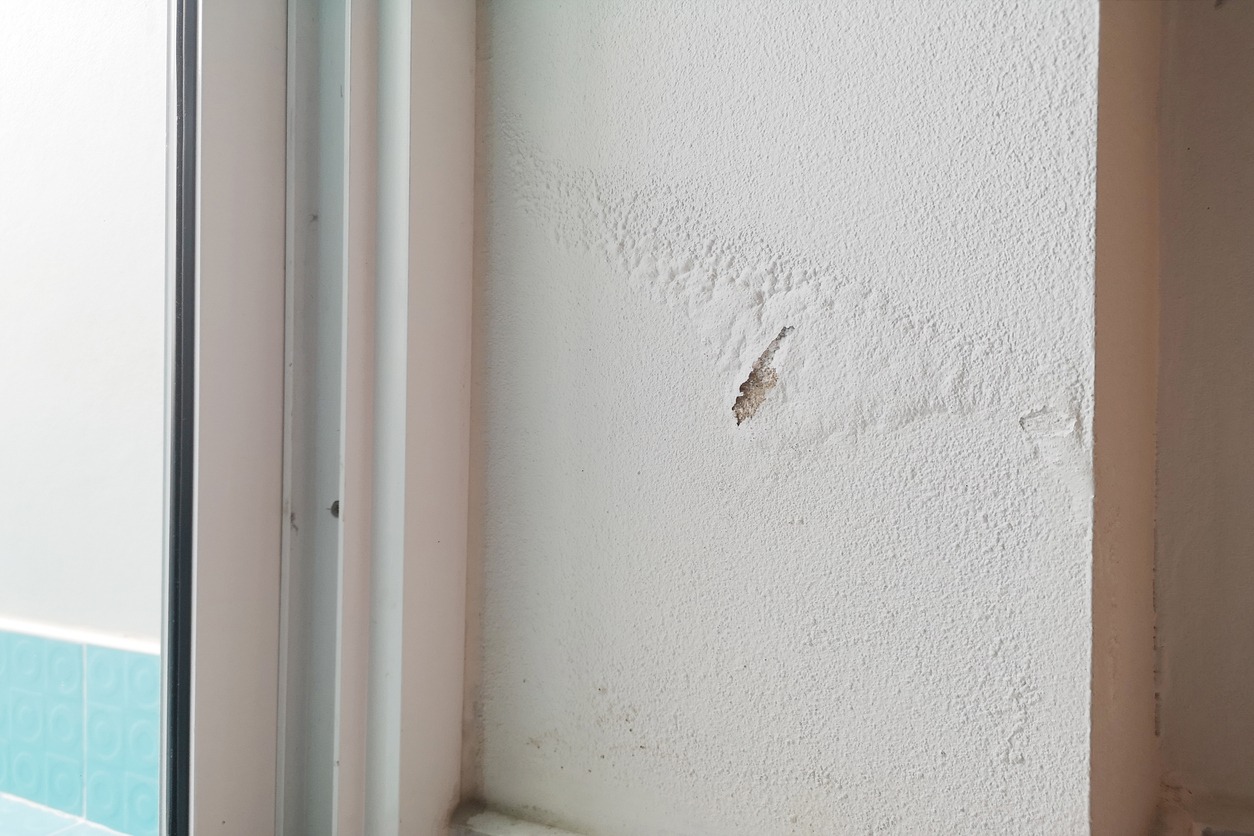Overview of antimicrobial paint
Suppose you have a persisting mold and mildew problem in your walls (especially in a humid area). In that case, use antimicrobial paint.
Antimicrobial paint is a specialized type of coating that contains agents designed to inhibit the growth of microbes such as bacteria, mold, and mildew. These paints incorporate antimicrobial additives, which can be chemical or natural, to create a surface hostile to microbial life. The additives disrupt the cellular processes of microbes, effectively preventing their growth and proliferation on painted surfaces.
Why homeowners might consider using it
Homeowners might consider using antimicrobial paint for several reasons:
- Health benefits: It can help reduce harmful bacteria and mold, resulting in a healthier indoor environment.
- Durability: Antimicrobial paint can extend the paint’s lifespan by preventing mold and mildew that can cause deterioration.
- Maintenance: Surfaces coated with antimicrobial paint are easier to clean and maintain as they resist microbial growth.
- Aesthetic appeal: By preventing mold and mildew, the paint helps maintain the aesthetic quality of walls and ceilings, particularly in high-moisture areas like bathrooms and kitchens.
Understanding antimicrobial paint
What is antimicrobial paint?
Definition and How it Works
Antimicrobial paint is a coating formulated to prevent the growth of microorganisms such as bacteria, mold, and mildew on painted surfaces. It works by incorporating antimicrobial agents into the paint that inhibit the growth and reproduction of these harmful microorganisms.
Active Ingredients and their functions:
- Silver ions: Silver ions are a common antimicrobial agent used in paints. They work by disrupting the cellular processes of bacteria, leading to their death.
- Copper compounds: Copper has natural antimicrobial properties and is effective in preventing the growth of bacteria and fungi.
- Zinc pyrithione: This compound is widely used for its ability to inhibit the growth of mold and mildew.
- Organic biocides: These are chemical agents that can kill or inhibit the growth of microorganisms. They are often combined with other agents to enhance the antimicrobial properties of the paint.
Benefits of antimicrobial paint
- Reducing the growth of bacteria, mold, and mildew: Antimicrobial paint significantly reduces the presence of harmful microorganisms on surfaces, creating a safer and more hygienic environment. It is particularly beneficial in areas prone to moisture, such as bathrooms and kitchens, where mold and mildew growth are common.
- Improving indoor air quality: By preventing the growth of mold and mildew, antimicrobial paint helps maintain better indoor air quality. Mold spores can significantly contribute to indoor air pollution, leading to respiratory issues and allergic reactions. Using antimicrobial paint can minimize these health risks.
- Enhancing cleanliness and hygiene: Surfaces coated with antimicrobial paint are easier to keep clean and hygienic. The antimicrobial agents continuously work to prevent bacteria buildup, reducing the need for frequent cleaning and disinfection. It is valuable in settings like hospitals, schools, and other public spaces where maintaining high hygiene standards is crucial.
Areas where antimicrobial paint is most beneficial
1. High-moisture areas
- Bathrooms and kitchens: These areas are prone to mold and mildew due to high humidity and frequent water exposure. Antimicrobial paint helps prevent the growth of harmful microbes, ensuring a cleaner and healthier environment.
- Basements and laundry rooms: These spaces often have limited ventilation and are susceptible to dampness, making them ideal candidates for antimicrobial paint to combat mold and mildew.
2. High-traffic areas
- Entryways and hallways: These zones see a lot of foot traffic and frequent surface touching, making them hotspots for germs and bacteria. Antimicrobial paint can reduce the spread of these microbes, promoting a healthier home.
- Living rooms and dining rooms: These common areas where families and guests gather can benefit from antimicrobial paint to minimize the spread of bacteria and maintain a cleaner space.
3. Homes with vulnerable individuals
- Households with children, elderly, or immunocompromised members: These individuals are more susceptible to infections and illnesses. Using antimicrobial paint in their living spaces can provide an additional layer of protection, contributing to their overall health and safety.
- Importance for health and safety: Antimicrobial paint can be crucial for a safer environment for vulnerable family members, reducing the risk of infections and contributing to better health outcomes.
Comparing antimicrobial paint to regular paint
Cost differences
- Initial investment vs. long-term benefits: Antimicrobial paints are generally more expensive upfront than regular paints. However, the long-term benefits, such as reduced maintenance costs due to their microbial-resistant properties, can offset the initial investment.
- Price comparison with standard paints: Antimicrobial paints can be 10-20% more expensive than traditional paints. The exact difference varies by brand and quality.
Performance and durability:
- Longevity and wear resistance: Antimicrobial paints are designed to be durable and long-lasting, often outperforming regular paints in high-moisture or high-traffic areas.
- Effectiveness in preventing microbial growth: These paints are highly effective in preventing the growth of bacteria, mold, and mildew, which can be especially beneficial in spaces like bathrooms and kitchens.
Aesthetic considerations:
- Availability of colors and finishes: Similar to regular paints, antimicrobial paints are available in a wide range of colors and finishes, ensuring that you can find options that fit your design preferences.
- Impact on the overall decor: Using antimicrobial paint can subtly enhance the overall decor by maintaining a cleaner, more hygienic environment without compromising on aesthetic appeal.
How to use antimicrobial paint effectively
Using antimicrobial paint effectively involves several key steps to ensure its long-term benefits and performance. Here’s a brief guide:
1. Proper surface preparation
- Cleaning and priming surfaces: Thoroughly clean the surfaces to remove dirt, grease, and mold. Apply a suitable primer to enhance paint adhesion.
- Ensuring surfaces are dry and free from contaminants: Make sure surfaces are completely dry and free from dust or any contaminants before painting.
2. Application tips
- Following the manufacturer’s instructions: Carefully read and adhere to the paint manufacturer’s mixing, application, and drying time guidelines.
- Using appropriate tools for best results: Use high-quality brushes or rollers suitable for antimicrobial paint to ensure even coverage and effectiveness.
- Using appropriate tools for best results: Use high-quality brushes or rollers suitable for antimicrobial paint to ensure even coverage and effectiveness.
3. Maintenance and care
- Cleaning painted surfaces without compromising antimicrobial properties: Clean the surfaces with mild, non-abrasive cleaners to avoid damaging the antimicrobial finish.
- Touch-up tips to maintain effectiveness: Regularly inspect and touch up any damaged or worn areas with the same antimicrobial paint to sustain its protective properties.
Potential drawbacks and considerations
Possible health concerns
- Understanding the safety of antimicrobial agents: It’s essential to know the specific antimicrobial agents used in the paint and their potential health effects. Some agents might pose risks if inhaled or come into contact with skin.
- Addressing concerns about chemical exposure: Prolonged exposure to certain chemicals in antimicrobial paints could lead to respiratory issues, skin irritation, or other health problems, particularly for sensitive individuals.
Environmental impact
- Eco-friendly options and certifications: Not all antimicrobial paints are created equal. Choosing products with eco-friendly certifications (like Green Seal or GREENGUARD) can help mitigate environmental impact.
- Balancing antimicrobial benefits with environmental responsibility: It’s crucial to weigh the benefits of antimicrobial properties against the potential environmental costs, as some agents might persist in the environment and cause harm to wildlife.
Limited effectiveness
- Realistic expectations for antimicrobial protection: Antimicrobial paints can inhibit the growth of bacteria and mold, but they are not a substitute for regular cleaning and maintenance. They are part of a broader strategy for maintaining hygiene.
- Situations where antimicrobial paint may not be necessary: In areas where mold and bacteria are not a significant concern, the added cost and potential drawbacks of antimicrobial paint may not be justified. Regular paint combined with proper ventilation and cleaning might suffice.
Alternatives to antimicrobial paint
1. Regular cleaning and maintenance
- Consistent cleaning routines are important. Regular cleaning helps maintain a healthy environment by preventing the buildup of mold, mildew, and bacteria.
- Using disinfectants and cleaners effectively: Utilizing appropriate disinfectants and cleaners ensures that surfaces are thoroughly sanitized, reducing the need for antimicrobial paint.
2. Other antimicrobial products
- Incorporating antimicrobial surfaces and materials: Materials like copper, silver, and certain plastics naturally resist microbial growth and can be used for surfaces such as countertops, doorknobs, and fixtures.
- Benefits of antimicrobial fabrics and coatings: Using antimicrobial fabrics for curtains, upholstery, and clothing, as well as applying antimicrobial coatings to various surfaces, provides an additional layer of protection against harmful microorganisms.
Conclusion
When choosing antimicrobial paints, consider factors such as effectiveness against specific microbes, durability, environmental impact, and cost. Weigh the benefits of reduced microbial growth and easier maintenance against potential drawbacks like higher prices or limited color options. Assess your personal needs and the specific conditions of your space.
Finally, to ensure the best outcome, we encourage you to contact our experts from Custom Painting, Inc. Call us at 925-294-8062 or message us on our contact page for a free consultation and estimate. We can provide expert advice and a high-quality finish tailored to your requirements.



